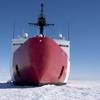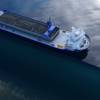New York Water Taxi, whose bright yellow water taxis shuttle passengers between locations on the New York Harbor, is adding two new vessels to its six-boat fleet.
Next spring, the water taxi service will take delivery of two 72-foot catamarans, under construction at Gladding-Hearn Shipbuilding, Duclos Corporation.
The new vessels are classic Incat Designs-designed ferries -- offering simplicity and efficiency, reliability, low sound level, and low wake. The water taxis are designed to reach the same 26-knot speed and with the same crew size as New York Water Taxi’s current vessels, but will have twice the interior passenger capacity.
“We are very pleased to win this project,” explained Peter Duclos, Gladding-Hearn’s president/director of business development. “We believe the experienced Gladding-Hearn/Incat team was able to offer the most economically viable vessel with proven design elements to work in the New York harbor environment.”
The all-aluminum water taxis measure 72 feet (22 m) long and 27.3 feet (2.3 m) abeam, and draw 4 feet (1.3 m), and each will carry 99 passengers.
Each vessel will be powered by two U.S. EPA Tier 2-compliant Cummins QSK 19-M diesel engines, each rated at 800 Bhp at 2100 rpm. The engines will drive 5-bladed Ni-BR-Al (nickel-bronze-aluminum) Bruntons propellers via Twin Disc MGX 5145SC “Quick Shift” gearboxes and EC-300 control systems to improve the vessel’s maneuverability and safety when bow landing.
The taxi’s carpeted main cabin will seat 99 passengers and be entirely accessible for passengers in wheel chairs. The exposed upper deck, behind the wheelhouse, seats 36 passengers and has standing room for another 39. Passengers will board and disembark through doors at the bow between the main cabin and foredeck. The foredeck will be heated so passengers won’t slip on ice and snow in the winter.
The main cabin will be outfitted with Beurteaux Ocean tourist seats, four TVs, a head, snack bar, and heating and air conditioning. Above the passenger doors will be an illuminated Horizon LED destination sign system. The wheelhouse will be equipped with a Next Bus System so passengers can check on the boat’s arrival time at each landing or from the Internet.
Featured videos

Inmarsat Enhances Service to Drive Digitalization

Inside the Electrified Truckable Tug

Tracking Foreign Vessels Working in the U.S. Jones Act Market
Subscribe for
Maritime Reporter E-News
Maritime Reporter E-News is the maritime industry's largest circulation and most authoritative ENews Service, delivered to your Email five times per week








